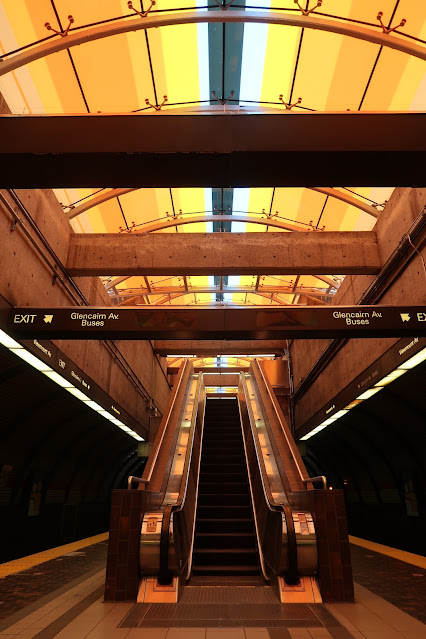“Don’t judge a book by its cover.”
Look no further than Glencairn for a splendid manifestation of this idiom. From the outside, this scarcely-used station resembles nothing so much as a monstrous concrete slug, oozing its gigantic mass between two ceaseless roadways.
 |
| In the 1970s, Soviet architecture was typified by an outright hostility to—oh, wait, this is Glencairn station. |
Yet upon entering the structure, all thoughts of its Brutalist exterior vanish, as we discover a sensuous cathedral of
glorious orange, brown, and sepia tones, that also happens to cosplay as a local neighbourhood subway stop.
 |
| The worshipful shot that every Instagrammer takes. |
Designed by Adamson Associates, Glencairn opened for revenue service on January 28, 1978 as part of the Spadina subway expansion, stretching languorously between the Allen-spanning bridges of Glencairn and Viewmont Avenues. It modestly serves Glen Park, a low-density residential area that is ripe for an upzoning that will probably never occur.
As with the other stops of the Spadina subway, Glencairn featured artwork that was deliberately incorporated into the station, as part of the Art in the Subway project.
Using translucent, pigmented, glazed panels in the skylight, Rita Letendre’s mural Joy stretched across the 180 feet of the station’s ceiling. An audacious stained-glass-like effect infused every nook of the station platform with a cascade of light during the day.
Unfortunately, the mediocre late 1970s window-sealant and gasket-engineering techniques employed by the TTC failed the test of durability: the roof constantly leaked. Huge swathes of the station’s beautiful brown and red platform floor tiling eventually had to be replaced. Letendre’s original work was removed in the early 1990s due to damage, and the station carried on bereft of its singular colours. I first visited Glencairn during this phase.
 |
| Glencairn during its ‘clear’, sterile years. |
By 2022, the whole skylight structure had to be redone. With Letendre’s input, a reinterpreted version of Joy (based on her 1977 painting, Ixtepec) was thankfully installed as part of the critical roof repairs. My gallery of photographs for Glencairn reflects these two dissonant states: pre, and post-restoration.
 |
| Totally tubular! |
The novel version of Joy lacks the dynamic violence of Letendre’s initial iteration. But that is a petty observation we can acknowledge and then immediately dismiss. I can think of no other artwork in the system that so profoundly influences our perceptual and emotional experience of a station (a claim reinforced by our having witnessed the place without it).
 |
| The entrance hall: joyous! |
The relentless light streaming from above fills this oft-overlooked station with a humbling, ethereal, happy glow that waxes and wanes to the pulse of the diurnal sun. I love it.
 |
| Glimpse into the retro-future of your heart’s secret desire—and release the past that ails you... |
It felt appropriate that I saved Glencairn for my penultimate, celebratory tour. The curves and angles and colours all combine in harmony, easing the way for a few precious moments of quiet reflection before the next train arrives. The long journey is nearly complete: a calm relief is slowly spreading through me.
Photo Gallery
Tour the station, and view captioned historical images from its past:
Transfer:
 |
| Glencairn station transfer |
More about Glencairn
TTC Station info | Map | Wikipedia: GlencairnMy next stop: Old Mill
Previous station: Castle Frank
Alphabetical Station Selector

